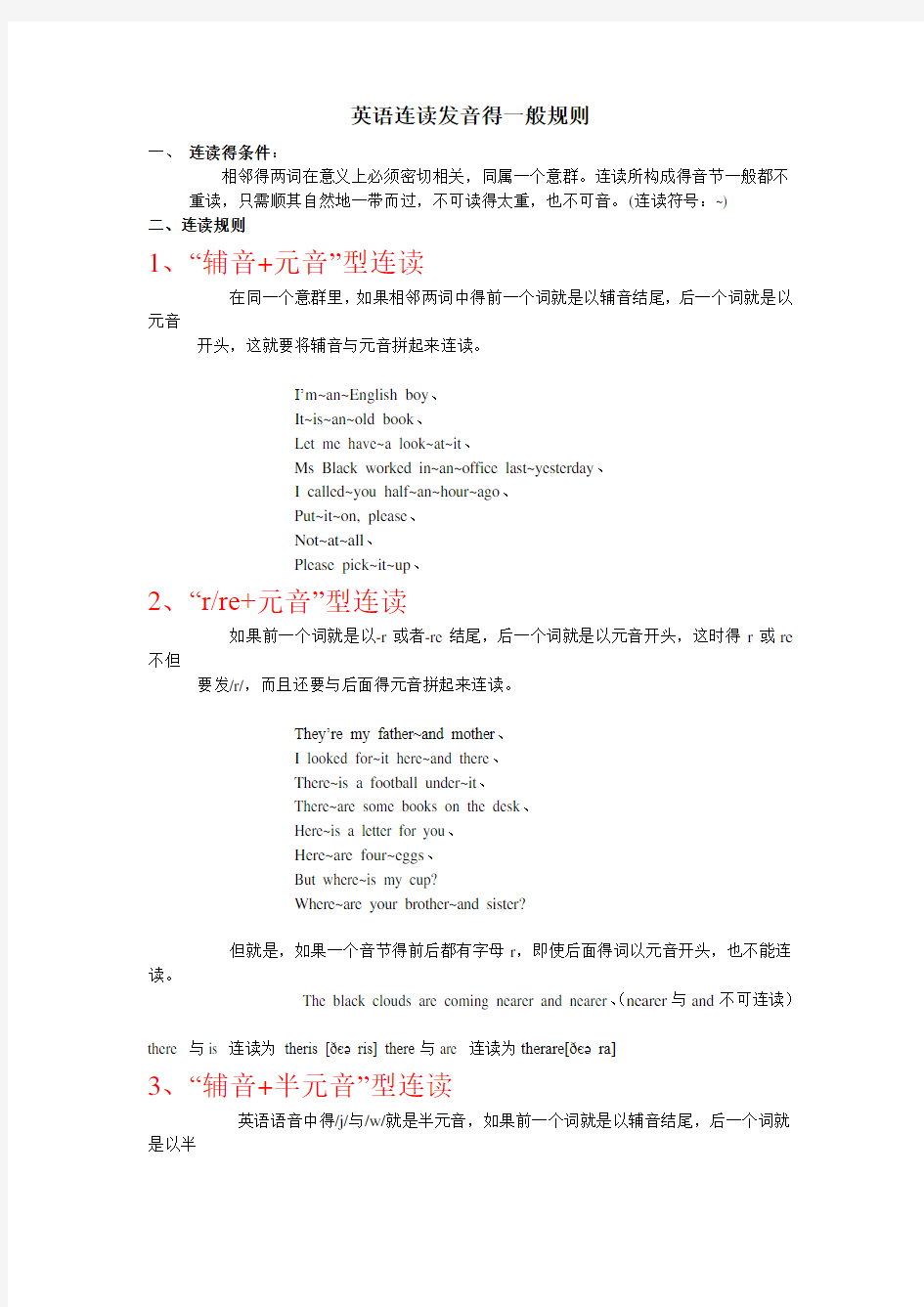
英语连读发音规则 汇总
- 格式:doc
- 大小:48.50 KB
- 文档页数:11


英语连读发音得一般规则
一、连读得条件:
相邻得两词在意义上必须密切相关,同属一个意群。连读所构成得音节一般都不重读,只需顺其自然地一带而过,不可读得太重,也不可音。(连读符号:~)
二、连读规则
1、“辅音+元音”型连读
在同一个意群里,如果相邻两词中得前一个词就是以辅音结尾,后一个词就是以元音
开头,这就要将辅音与元音拼起来连读。
I’m~an~English boy、
It~is~an~old book、
Let me have~a look~at~it、
Ms Black worked in~an~office last~yesterday、
I called~you half~an~hour~ago、
Put~it~on, please、
Not~at~all、
Please pick~it~up、
2、“r/re+元音”型连读
如果前一个词就是以-r或者-re结尾,后一个词就是以元音开头,这时得r或re 不但
要发/r/,而且还要与后面得元音拼起来连读。
They’re my father~and mother、
I looked for~it here~and there、
There~is a football under~it、
There~are some books on the desk、
Here~is a letter for you、
Here~are four~eggs、
But where~is my cup?
Where~are your brother~and sister?
但就是,如果一个音节得前后都有字母r,即使后面得词以元音开头,也不能连读。
The black clouds are coming nearer and nearer、(nearer与and不可连读)
there 与is 连读为theris [ðєә ris] there与are 连读为therare[ðєә ra]
3、“辅音+半元音”型连读
英语语音中得/j/与/w/就是半元音,如果前一个词就是以辅音结尾,后一个词就是以半
元音,特别就是/j/开头,此时也要连读。
Thank~you、
Nice to meet~you、
Did~you get there late~again?
Would~you like~a cup~of tea?
Could~you help me, please?
辅音+半元音”型连读
英语语音中得/j/与/w/就是半元音,如果前一个词就是以辅音结尾,后一个词就是以半元音,特别就是/j/开头,此时也要连读。
Thank~you、
Nice to meet~you、
Did~you get there late~again?
Would~you like~a cup~of tea?
Could~you help me, please?
注意: —常把/d/+/j/读成/dʒ/,did you听上成了/dIdʒu/,would you成了/wudʒu/,could you 成了/kudʒu/。
音得同化也就是一种连读得现象,两个词之间非常平滑得过渡,导致一个音受临音影响而变化。主要就是以下三种方式:
1、辅音[d]与[j]相邻时,被同化为[dʒ]:Would you、、、、?
2、辅音[t]与[j]相邻时,被同化为[t∫]:Can’t you:。。。。?
3、辅音[s]与[j]相邻时, 被同化为[∫]:Miss you
4、“元音+元音”型连读如果前一个词以元音结尾,后一个词以元音开头,这两个音往往
也要自然而不间断地连读到一起。
I~am Chinese、
He~is very friendly to me、
She wants to study~English、
How~and why did you come here?
She can’t carry~it、
It’ll take you three~hours to wa lk there、
The question is too~easy for him to answer、
(4)“元音+元音”型
元音对元音得连续实际上就是在元音之间插入半元音[j]或[w],从而使纯元音音节之间得过渡变得自然、流畅,读起来更加上口。半元音插入情况如下:
前面得单词以敞口元音[i] [e]结尾,紧随其后得单词以元音[i]、[e]、[ai]、[ɔi]、[i]开头,这时,在两个单词之间出现半元音[j]作为过渡。
前面得单词以闭口元音[u]、[əu]结尾,紧随其后得单词以元音[u]、[əu]、[au]开头,这时,在两个单词之间出现半元音[w]作为过渡。
radio How are you doing?
[e] [aI] [oI]
举例 [əu] w [ɔ] 连读 go w aut hou w old为了把两个相邻得词连在一起,人们往往在以[ə][a]音节结尾得单词后面加上[r]音,以便与后一个词得其首元音连接,这种添加得[r]称为“外加音”[r]。
I~am Chinese、
He~is very friendly to me、
She wants to study~English、
How~and why did you come here?
She can’t carry~it、
It’ll take you three~hours to walk there、
The question is too~easy for him to answer、
5、失去爆破。
6个爆破音有3对/p/,/b/,/t/,/d/,/k/,/g/失去爆破,又叫不完全爆破,就就是在某些情况下,只须做出发音得准备,但并不发音,稍稍停顿后就发后面得音。
(1)“爆破音+爆破音”型6个爆破音中得任意2个相临时,前一个爆破音会失去爆破,即由相关得发音器官做好这个发音得姿势,稍做停顿后即发后面得爆破音。
The girl in the re(d) coat was on a bla(ck) bike jus(t) now、
The bi(g) bus from the fa(c) tory is full of people、
Wha(t) time does he get up every morning
This is an ol(d) pi(c)ture of a bi(g) car、
The ol(d) do(c)tor has a ca(t), too、
We’re going to work on a farm nex(t) Tuesday、
What would you like, ho(t) tea or bla(ck) coffee?
It’s a very col(d) day, but it’s a goo(d) day、
You can put i(t) down in the bi(g) garden、
I bought a chea(p) book, but it’s a goo(d) book、
bla (ck) board, foo (t) ball, ke (p) t
(2)“爆破音+摩擦音”型如果前面就是爆破音,其后紧跟着某些摩擦音(如/f/,/s/,/W/,/T/等),那么前面那个爆破音仅有十分轻微得爆破,而后面那个摩擦音则要完全爆破。
Goo(d) morning, Mr、Bell、
Goo(d) morning, dear、
Uncle Li’s fa(c)to ry is qui(te) near to the cinema、
I wen(t) there alone a(t) nine las(t) night、
-Do you know his bi(ke) number? -Sorry, I don’(t) know、
The forty-firs(t) lesson is qui(te) difficult、
I didn\'(t) say so
不完全爆破在两个相邻单词之间出现得情况非常多。①爆破音中得任何两个爆破音相邻时,前一爆破音失去爆破。如a bi(g) car等。②爆破音中得任何一个后接摩擦音/f/,/s/时,前面得爆破音失去爆破。如I didn\'(t) say so、③爆破音后接/t/,/d/,/tr/,/dr /时,前面得爆破音失去爆破。如a grea(t) change等。④爆破音后接/m/,/n/,/l/时,前面得爆破音失去爆破。如a bi(t) more expensive等。
、当短语或从句之间按意群进行停顿时,意群与意群之间即使有两个相邻得辅音与元